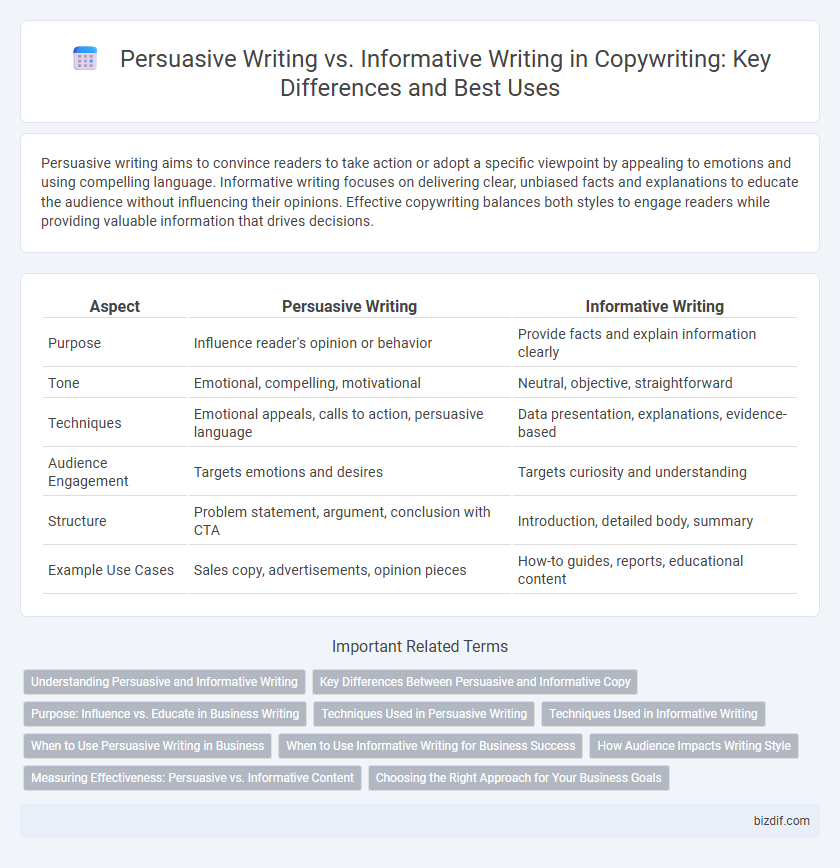Persuasive writing aims to convince readers to take action or adopt a specific viewpoint by appealing to emotions and using compelling language. Informative writing focuses on delivering clear, unbiased facts and explanations to educate the audience without influencing their opinions. Effective copywriting balances both styles to engage readers while providing valuable information that drives decisions.
Table of Comparison
| Aspect | Persuasive Writing | Informative Writing |
|---|---|---|
| Purpose | Influence reader's opinion or behavior | Provide facts and explain information clearly |
| Tone | Emotional, compelling, motivational | Neutral, objective, straightforward |
| Techniques | Emotional appeals, calls to action, persuasive language | Data presentation, explanations, evidence-based |
| Audience Engagement | Targets emotions and desires | Targets curiosity and understanding |
| Structure | Problem statement, argument, conclusion with CTA | Introduction, detailed body, summary |
| Example Use Cases | Sales copy, advertisements, opinion pieces | How-to guides, reports, educational content |
Understanding Persuasive and Informative Writing
Persuasive writing aims to influence the reader's beliefs or actions through emotional appeal, strong arguments, and clear calls to action, often seen in advertisements and opinion pieces. Informative writing focuses on delivering facts, explanations, and data to educate the audience without bias, commonly used in news reports and educational content. Understanding the differences enables copywriters to tailor their messages effectively, enhancing audience engagement and achieving communication goals.
Key Differences Between Persuasive and Informative Copy
Persuasive writing aims to influence the reader's opinions or actions by appealing to emotions and using compelling calls to action, while informative writing focuses on delivering clear, factual, and unbiased information to educate the audience. Persuasive copy often employs rhetorical devices, storytelling, and strong language to drive conversions, whereas informative copy prioritizes clarity, accuracy, and detail to build trust and understanding. Understanding these key differences helps copywriters tailor their content strategy to achieve specific marketing objectives effectively.
Purpose: Influence vs. Educate in Business Writing
Persuasive writing aims to influence readers' attitudes or actions by appealing to emotions and presenting compelling arguments, often used in marketing and sales materials. Informative writing focuses on educating the audience by providing clear, factual, and unbiased information, crucial for reports, manuals, and whitepapers. Understanding the distinct purpose of each style enables businesses to craft messages that either drive decision-making or enhance knowledge effectively.
Techniques Used in Persuasive Writing
Persuasive writing employs emotional appeals, strong calls to action, and rhetorical questions to influence the reader's attitude or behavior. Techniques such as repetition, anecdotal evidence, and social proof enhance credibility and engagement. The strategic use of persuasive language aims to evoke agreement and prompt immediate response.
Techniques Used in Informative Writing
Informative writing employs techniques such as clear explanations, factual evidence, and logical organization to convey knowledge effectively. It uses objective language, data, and examples to enhance understanding and credibility. Visual aids like charts and infographics often support the text, making complex information more accessible.
When to Use Persuasive Writing in Business
Persuasive writing in business is essential when the goal is to influence customer decisions, such as during sales pitches, marketing campaigns, and promotional content to drive conversions. It excels in scenarios requiring emotional appeal and compelling calls to action to boost brand loyalty and customer engagement. Companies use persuasive writing to highlight unique selling points and differentiate products in competitive markets, maximizing impact and revenue.
When to Use Informative Writing for Business Success
Informative writing is essential for businesses aiming to educate their audience about products, services, or industry insights with clarity and precision. By providing factual, unbiased content such as how-to guides, product descriptions, and case studies, companies build trust and establish authority within their market. Leveraging informative writing during product launches, customer onboarding, or thought leadership initiatives enhances customer understanding and drives long-term business success.
How Audience Impacts Writing Style
Audience understanding critically shapes both persuasive and informative writing styles, dictating tone, vocabulary, and content complexity to match readers' knowledge and expectations. Persuasive writing targets emotions and desires, tailoring messages to influence decision-making, often using compelling calls to action that resonate with specific audience motivations. Informative writing prioritizes clarity and factual accuracy, adapting explanations and detail depth to the audience's existing expertise and informational needs.
Measuring Effectiveness: Persuasive vs. Informative Content
Measuring the effectiveness of persuasive writing relies heavily on metrics like conversion rates, click-through rates, and audience engagement that indicate behavioral change. Informative writing's success is best gauged through comprehension tests, knowledge retention, and feedback accuracy, reflecting the depth of understanding imparted. Both approaches demand tailored analytics aligned with their distinct goals to accurately assess content impact.
Choosing the Right Approach for Your Business Goals
Persuasive writing drives conversions by appealing to emotions and encouraging immediate action, making it ideal for marketing campaigns and sales-driven content. Informative writing builds trust and authority through clear, factual content, suitable for educating customers and establishing expertise. Aligning your writing style with your business goals ensures the content effectively supports brand growth and customer engagement.
Persuasive Writing vs Informative Writing Infographic

 bizdif.com
bizdif.com